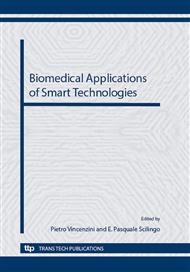p.51
p.59
p.63
p.70
p.75
p.81
p.86
p.92
p.102
Characterization of Hydrogels Based on PVP/Sodium Alginate Containing Pseudoboehmites Nanoparticles Treated with Octadecylamine for Pharmaco Applications
Abstract:
Abstract. Hydrogels based on poly (N-vinyl-2-pyrrolidone) (PVP) obtained by ionizing radiation are sterile, biocompatible can be used as topics dressings. Due to the high degree of hydration of the gel, it has a low mechanical strength, which is one of the biggest problems in its application. The objective of this work was to study the properties of the hydrogel based on PVP / sodium alginate containing pseudoboehmites nanoparticles treated with octadecylamine for pharmaco applications, order drug release when immobilized on a matrix of PVP/sodium alginate/pseudoboehmite. Pseudoboehmite nanoparticles were obtained by sol-gel route, from aluminum nitrate and ammonia as precursors, and subsequently were treated with octadecylamine. The hydrogels based on PVP/sodium alginate/pseudoboehmite treated were prepared by ionizing radiation with doses of 30 and 35kGy. The characterization of hydrogels obtained was made by means of thermomechanical (tensile tests, DTA and TG) and physicochemical (swelling, sol-gel fraction) tests. The results obtained showed that the hydrogel based only on PVP and sodium alginate showed highest tensile strength. The presence of pseudoboehmite in the hydrogels decreases the formation of crosslinks, while the presence of PEG in the agar and causes a decrease in Tg of the polymer matrix.
Info:
Periodical:
Pages:
92-101
Citation:
Online since:
September 2012
Price:
Сopyright:
© 2013 Trans Tech Publications Ltd. All Rights Reserved
Share:
Citation:


